
Reisereise Schottland
Alles über Schottland
Attraktionen Golfaktivitäten

South Street St Andrews
South Street is where you will find St Mary's Quad
and the Gregory meridian. The oldest part of the University
and the town gate (west port). Madras College Blackfriars Chapel ruins, the Town Hall and many other historic sites.
Der Westhafen
Süd-Straße St Andrews Schottland
Der Westhafen wurde um 1580 erbaut und ist das einzige Tor in seiner ursprünglichen Position in Schottland. Es scheint nicht Teil einer Stadtmauer zu sein, die im Falle einer Invasion durch die Engländer geschlossen worden wäre. Das Tor wurde 1843 umfassend renoviert. Über der Mitte des Bogens befindet sich das Wappen von St. Andrews


Gavin Douglas 1474 - 1522
Gavin Douglas wurde in Tantallon Castle East Lothian geboren.
Er war der dritte Sohn von Archibald "Bell the Cat" Douglas 5th Earl of Angus. und hatte ein Haus in der Nähe dieser Stelle. Als Student der St. Andrews University war er ein Dichter, der für seinen "Palice of Honour" bekannt war. und für seine "Eneados" eine Übersetzung von Vergils "Aeneis" ins Schottische. Er war Dekan von St. Giles Edinburgh im Jahr 1501 und Bischof von Dunkeld im Jahr 1515. Gestorben 1522 London an der Pest. Sein Wappen war einmal über der Plakette, siehe unten, wie es aussah.

Madras College
South Street St Andrews
Madras College first opened in 1833 and takes its name from founder the Rev. Dr Andrew Bell and the educational system he devised.
see his plaque beside Blackfriars Chapel.

Blackfriars-Kapelle


Die Blackfriars Chapel wurde 1525 erbaut und 1547 durch einen Brand beschädigt und 1559 von einem Protestanten während der Reformation zerstört. Das Gebäude in der South Street ist alles, was übrig geblieben ist.
Charles Lapworth Plaque
South Street St Andrews
Charles Lapworth was a teacher at Madras College 1875 – 1881.
A self-taught Geologist was the founder of a new geological time (The Ordovician Period)
He became a Professor of Geology in 1881 at Birmingham University.
Plaque Reads:
CHARLES LAPWORTH, LLD, FRS, 1842-1920
Between 1875 and 1881 Lapworth was a teacher of English at Madras College. In his spare time he studied the Rocks of extinct creatures called Graptolites to help unravel the complexities of these ancient rocks. As a result of his careful studies, he proposed anew division of geological time, The Ordovician Period that is now recognised and used internationally. He also correctly interpreted the Moine Thrust Fault Zone in the North West Highlands of Scotland as amass of older rocks pushed over younger ones, an idea which at the time conflicted with orthodoxy. He left St Andrews in 1881 to become Professor of Geology at the University of Birmingham.

Dr Andrew Bell Plaque
South Street St Andrews
Dr Bell was born in South Street St Andrews in 1753
he died in 1832. Son of Bailie Bell, Andrew was Founder of the Madras College in 1833 he pioneered
the Madras System of Education.
Teaching system which went worldwide,
where older children taught younger children.
Plaque reads:
The Reverend Dr Andrew Bell 1753 – 1832
An educational reformer and philanthropist. He was born in
St Andrews. It was while serving in Madras in India that he developed a form of schooling where
the older pupils taught the younger.
When he returned he introduced his “Madras” or monitorial system as an economical form of mass education. The idea spread, Madras Schools appearing in Canada and Australia. Among the other local benefactions was the Bell fund for the benefit of St Andrews. He ended his career as Prebendary of Westminster Abbey. Where he is buried.

Dr. John Adamsons Haus


Dr. John Adamson 1809 - 1870 lebte hier 1845 - 1865
Er war Arzt und Pionierfotograf.
1841 auch er das erste Kalotypie-Porträt.
Er lehrte auch seinen Bruder Robert und Thomas Rodger die Technik und Kunst der Fotografie.
Holy Trinity Church
South Street St Andrews
The Holy Trinity Church originally stood close to St Andrews Cathedral
and was built in 1144.
It has been in its present position in South Street since 1412.
Originally served by Roman Catholic priests
it changed with the Reformation in 1559
to Protestant and Episcopalian priests.
Since 1689 the ministers have been Presbyterian.
The Tower and two interior arches are the only original parts of the church from 1412 that remain.
1907 the church was demolished and rebuilt to the previous medieval church’s footprint and rededicated on St Andrews Day in 1909.

The Sharp Aisle
The Sharp Aisle, contains the tomb and monument to Archbishop Sharp (1618-1697),
Sharpe was murdered by Covenanters at Magus Muir 1697.
The Great East Window
Dated from 1910
The Good Physician
Dated from 1890 is the only surviving window prior to the reconstruction of the church in 1909.
John Knox Porch
In 1547 Holy Trinity was the scene of the first public sermon
of the famous reformer, John Knox.
He also preached in Holy Trinity in 1559, instructing residents of St Andrews to purge the city of "monuments of idolatry". Inspired by Knox's the local population rejected Catholicism, tore down statues and altars, and sacked St Andrews Cathedral.

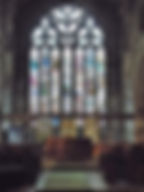
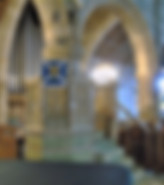
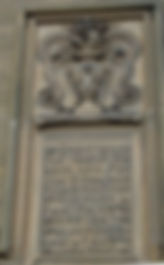
Rathaus von St. Andrews
Queens Gardens
St Andrews
KY16 9TA
Schottland

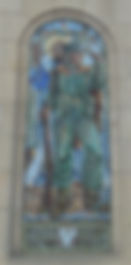
St Andrews Town Hall, das 1858 für kommunale und öffentliche Zwecke errichtet wurde
Sir Hugh Playfair Provost.
Polnisches Soldatendenkmal St. Andrews
Robert Burns Club Plaque
South Street St Andrews
St Andrews Burns Club Plaque
Can be found on what was the Royal Hotel where the club was founded
on 25th January 1869.
13 in the Robert Burns World Federation
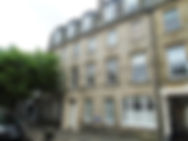


Hamish McHamish-Statue
Logies Lane
St Andrews
KY16 9NL
Schottland

Hamish McHamish war eine rotbraune Katze (im Alter von 15 Jahren), die in St. Andrews, Schottland, lebte.
Er wurde zum internationalen Star, als ein Buch mit dem Titel Hamish McHamish of St Andrews: Cool Cat About Town veröffentlicht wurde. Hamish ist ein Social-Media-Star mit seiner eigenen Facebook-Seite https://www.facebook.com/HamishMcHamishOfStAndrews und seinem Twitter-Account @Hamish_McHamish. Eine nomadische Katze, die von vielen Bewohnern von St. Andrews gepflegt wurde. Einst im Besitz von Marianne Baird.
Bailie Bell's House and Foundry
South Street St Andrews

In 1620 Edward Raban came to
St Andrews and set up a printing press in a building on the corner of North Street and Church Street.
This was later demolished by Bailie Bell in 1740 so he could build his house. This house is where his son was born in 1753 (Andrew). Andrew was to found Madras College and the "monitorial system" of education.
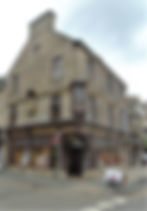
Royal Coat of Arms Tablet
South Street St Andrews
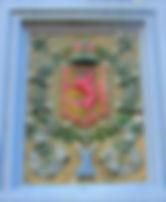
George Martine von Claremont
George Martine von Claremont 1635 -1712
Lebte in der South Street Er war ein Anwaltskommissar von St. Andrews und Autor der Ersten Geschichte des Erzbistums: - "Reliquiae Divi Andreae"

George Martine FRS 1700 - 1741
George war Arzt, Chirurg und Geologe, der später in der 56 South Street lebte. Er war der erste, der Wärme und Temperaturskalen sorgfältig untersuchte, und machte die erste Schätzung -400F der absoluten Nulltemperatur, Er stellte das erste nützliche Quecksilber in einem Fieberthermometer aus Glas her. Hier führte er 1730 die erste Tracheotomie in Großbritannien durch
James David Forbes House
South Street St Andrews
James David Forbes was born in Edinburgh 20 April 1809
at 86 George Street.
He was educated at Edinburgh University in 1825. At 19, became a fellow of the Royal Society of Edinburgh, and in 1832
he was elected to the
Royal Society of London.
In 1859 he was appointed successor to David Brewster as principal of the United College of St Andrews, which he held until his death in 1868. It could be said he was first to study the heating of the earth.


James Boswell und Samuel Johnson
Dies ist der Standort des Glass Inn 29 South Street, wo Boswell und Dr. Johnson am 18. August 1773 zu Abend aßen.
Wir hatten eine triste Fahrt in einer dunklen Nacht nach St Andrews, wo wir spät ankamen. Wir fanden ein gutes Abendessen im Glass's Inn.
Das Glass Inn überlebte um 1830

St Andrews
Sehenswürdigkeiten
Kirche der Heiligen Dreifaltigkeit
St Mary's Places
St Andrews
KY16 9UY
Schottland
Tom Morris Grab
Die Anhänge
St Andrews
KY16 9RG
Bell Pettigrew Museum
Bute medizinische Gebäude
Fakultät für Biologie
Terrasse der Königin
St Andrews
KY16 9TS
Darnleys Gin
Brennerei-Tour
East Newhall Farm
Königsscheune
St Andrews
KY16 8QE
Schottland
Pfarrkirche Kingsbarns
Hauptstraße
Königsscheune
St Andrews
KY16 8SS
Schottland
St. Andrews Pier
St Andrews
KY16 9RG
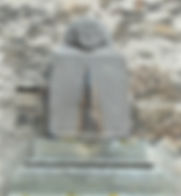
James Gregorys
Meridianlinie
Süd-Straße St Andrews Schottland James Gregory war der erste Regius-Professor für Mathematik.
Er legte 1748 einen Meridian. Er und zwei andere waren die Begründer der Infinitesimalrechnung.
Er erfand das gregorianische Teleskop Um mehr über Gregorys Arbeit zu erfahren, gehen Sie zu


